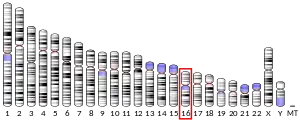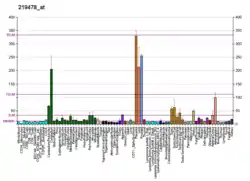WAP four-disulfide core domain protein 1 is a protein that in humans is encoded by the WFDC1 gene.[5][6]
This gene encodes a member of the WAP-type four disulfide core domain family. The WAP-type four-disulfide core domain, or WAP signature motif, contains eight cysteines forming four disulfide bonds at the core of the protein, and functions as a protease inhibitor in many family members. The encoded protein shares 81% amino acid identity with the rat ps20 protein, which was originally identified as a secreted growth inhibitor. This gene is mapped to chromosome 16q24, an area of frequent loss of heterozygosity in cancers, including prostate, breast and hepatocellular cancers and Wilms' tumor. Owing to its location and a possible growth inhibitory property of its gene product, this gene is suggested to be a tumor suppressor gene.[6]
References
- 1 2 3 GRCh38: Ensembl release 89: ENSG00000103175 - Ensembl, May 2017
- 1 2 3 GRCm38: Ensembl release 89: ENSMUSG00000023336 - Ensembl, May 2017
- ↑ "Human PubMed Reference:". National Center for Biotechnology Information, U.S. National Library of Medicine.
- ↑ "Mouse PubMed Reference:". National Center for Biotechnology Information, U.S. National Library of Medicine.
- ↑ Larsen M, Ressler SJ, Gerdes MJ, Lu B, Byron M, Lawrence JB, Rowley DR (Sep 2000). "The WFDC1 gene encoding ps20 localizes to 16q24, a region of LOH in multiple cancers". Mamm Genome. 11 (9): 767–73. doi:10.1007/s003350010135. PMID 10967136. S2CID 2474630.
- 1 2 "Entrez Gene: WFDC1 WAP four-disulfide core domain 1".
Further reading
- Alvarez R, Reading J, King DF, et al. (2008). "WFDC1/ps20 is a novel innate immunomodulatory signature protein of human immunodeficiency virus (HIV)-permissive CD4+ CD45RO+ memory T cells that promotes infection by upregulating CD54 integrin expression and is elevated in HIV type 1 infection". J. Virol. 82 (1): 471–86. doi:10.1128/JVI.00939-07. PMC 2224370. PMID 17942534.
- Otsuki T, Ota T, Nishikawa T, et al. (2007). "Signal sequence and keyword trap in silico for selection of full-length human cDNAs encoding secretion or membrane proteins from oligo-capped cDNA libraries". DNA Res. 12 (2): 117–26. doi:10.1093/dnares/12.2.117. PMID 16303743.
- Gerhard DS, Wagner L, Feingold EA, et al. (2004). "The status, quality, and expansion of the NIH full-length cDNA project: the Mammalian Gene Collection (MGC)". Genome Res. 14 (10B): 2121–7. doi:10.1101/gr.2596504. PMC 528928. PMID 15489334.
- Watson JE, Kamkar S, James K, et al. (2004). "Molecular analysis of WFDC1/ps20 gene in prostate cancer". Prostate. 61 (2): 192–9. doi:10.1002/pros.20100. PMID 15305342. S2CID 24557545.
- Ota T, Suzuki Y, Nishikawa T, et al. (2004). "Complete sequencing and characterization of 21,243 full-length human cDNAs". Nat. Genet. 36 (1): 40–5. doi:10.1038/ng1285. PMID 14702039.
- McAlhany SJ, Ressler SJ, Larsen M, et al. (2003). "Promotion of angiogenesis by ps20 in the differential reactive stroma prostate cancer xenograft model". Cancer Res. 63 (18): 5859–65. PMID 14522910.
- Strausberg RL, Feingold EA, Grouse LH, et al. (2003). "Generation and initial analysis of more than 15,000 full-length human and mouse cDNA sequences". Proc. Natl. Acad. Sci. U.S.A. 99 (26): 16899–903. Bibcode:2002PNAS...9916899M. doi:10.1073/pnas.242603899. PMC 139241. PMID 12477932.
- Saffroy R, Riou P, Soler G, et al. (2002). "Analysis of alterations of WFDC1, a new putative tumour suppressor gene, in hepatocellular carcinoma". Eur. J. Hum. Genet. 10 (4): 239–44. doi:10.1038/sj.ejhg.5200795. PMID 12032731.




